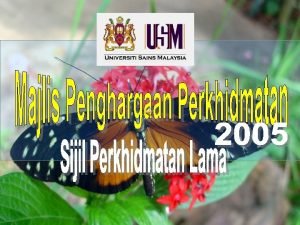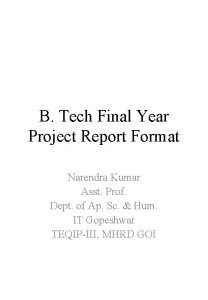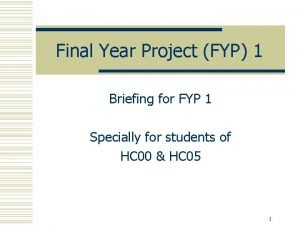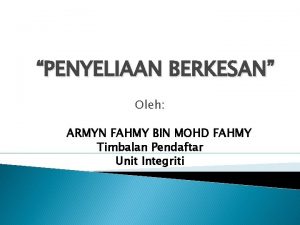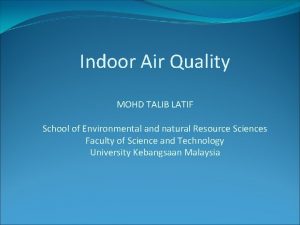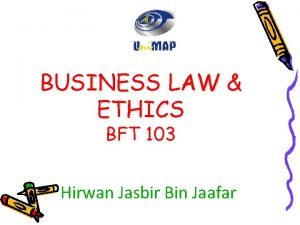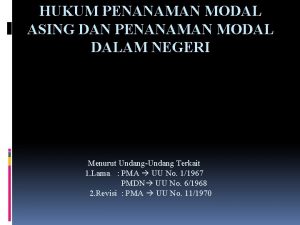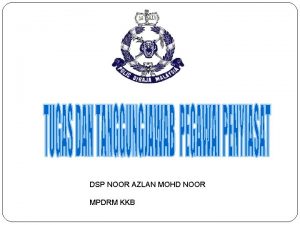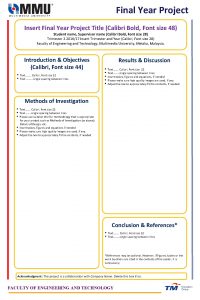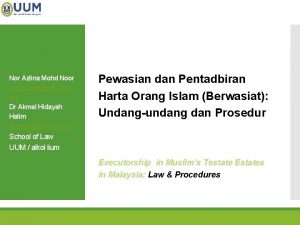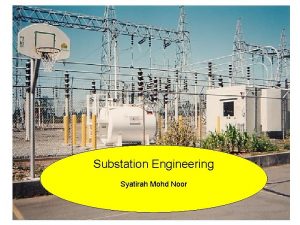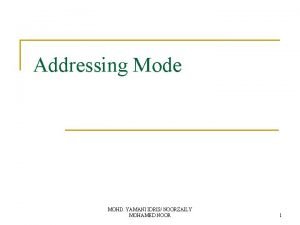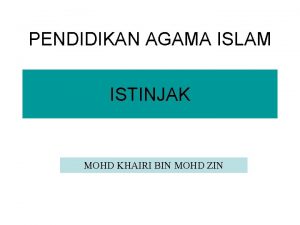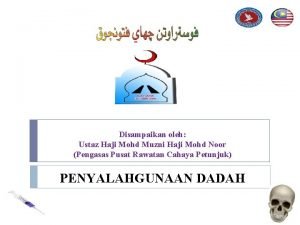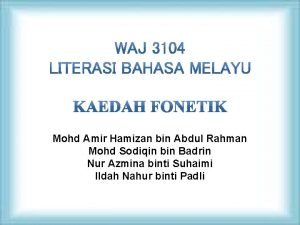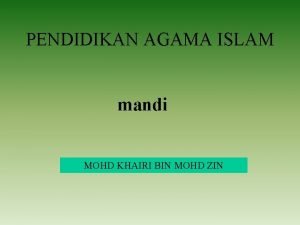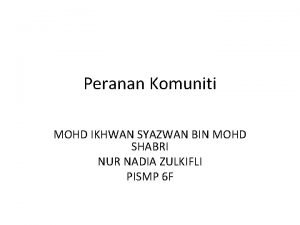Final Year Project Seminar Presentation Azizan Mohd Noor
























- Slides: 24

Final Year Project – Seminar Presentation Azizan Mohd. Noor Uni. KL MICET 1

Why do I need to do well in Presentations? • Phase 1 – 35% • Phase 2 – 30% • Approx. 32. 5% of 6 credits; equivalent to 1. 95 credits of the total marks in the assessment of the project (6 credits) comes from Presentations. • Presentation is only for 30 min each • For a normal course 1. 95 credits would be equivalent to approximately 18 h of lectures or 336 h of lab. time; in 14 weeks! • WORTH YOUR WHILE TO DO WELL! 2

Prerequisites for a good seminar presentation • • • Good research Good understanding of your research Well prepared materials 3

Preparation of seminar materials • Suitable for the time allocated ie. 20 min presentation and 10 min Q&A • Suitable medium for presentation – Powerpoint being the usual choice • Precise and concise 4

Content of a seminar presentation • • • Introduction Objective(s) Materials and methods Results and discussion Conclusion 5

Introduction • A brief description of the background of the research • Current status of knowledge in the area of research • Importance of the research Intro 1 6

Poly(3 -hydroxyalkanoate) PHA An intracellular storage material accumulated by a wide variety of microorganisms O C (CH 2)n C R Intro 2 O 100 -30 000 7

PHA can be divided into: • Short-chain-length PHA (scl-PHA) eg: 3 -hydroxypropionate, 3 -hydroxybutyrate, 4 -hydroxybutyrate, 3 -hydroxyvalerate • Medium-chain-length (mcl-PHA) eg: 3 -hydroxyhexanoate, 3 -hydrooctanoate, 3 -hydroxydecanoate Intro 3 8

The type of PHAs produced depends on: • Bacteria strains • Carbon sources • Culture conditions Intro 4 9

Some uses of PHAs • Degradable packaging for consumer products eg. bottles, bags, films • Drug-release matrix devices • Starting material for the synthesis of enantiomeric pure chemicals • Paint industry – as a binder Intro 5 10

Objectives • To screen for local PHA producers • To optimize the culture conditions • To manipulate the molecular weight of the polymer(s) 11

Materials and methods • Main methods used • Concise – use diagrams or flow-charts if possible Materials n methods 1 12

Procedure Soil samples (1 g) obtained from various locations were suspended in 10 ml of sterile distilled water. The suspensions were then plated out on nutrient agar and incubated at room temperature. Colonies producing biopolymer were identified by the flourescent orange colour formed upon flooding with Nile Blue A. To assess the efficacy of PHA production by the various isolates, the colonies were grown in semisynthetic liquid medium with glucose as the Csource. The cultures were incubated aerobically for 7 days after which the PHA produced were determined using a gas-liquid chromatograph. 13 Materials n methods 2

Procedure Soil samples (1 g) obtained from various locations were suspended in 10 ml of sterile distilled water. The suspensions were then plated out on nutrient agar and incubated at room temperature. Colonies producing biopolymer were identified by the flourescent orange colour formed upon flooding with Nile Blue A. To assess the efficacy of PHA production by the various isolates, the colonies were grown in semi-synthetic liquid medium with glucose as the C-source. The cultures were incubated aerobically for 7 days after which the PHA produced were determined using a gas-liquid chromatograph. Materials n methods 3 14

Procedure Screening Growth of USM 4 -55 in specific medium Aerobic fermentation (shake flask) Cell harvesting Cell drying (freeze-drying) GC polymer extraction Molecular weight analysis Materials n methods 4 15

Results • Very improtant • Concise • Arranged according to the objectives of the seminar • Table, graph or photo? Results 1 16

Effect of C/N molar ratio on production of polymer from oleic acid by USM 4 -55 Cell dry weight (g/l) Polyester content (wt%) 3 C 4 3 C 6 3 C 10 3 C 8 3 C 12: 1 3 C 14 10 4. 50 25 22 2 24 26 15 2 10 15 3. 88 26 23 2 24 25 10 1 14 20 2. 92 37 14 1 31 32 9 1 12 30 1. 60 43 19 1 24 30 12 1 13 40 1. 25 50 8 1 28 32 12 1 18 C/N (mol/mol) Polyester composition 3 C 4 - 3 -hydroxybutyrate, 3 C 6 - 3 -hydroxyhexanoate, 3 C 8 - 3 -hydroxyoctanoate, 3 C 10 - 3 -hydroxydecanoate, 3 C 12 - 3 -hydroxydodecanoate, 3 C 12: 1 - 3 -hydrododecenoate, 3 C 14 - 3 -hydroxytetradecanoate Results 2 17

Effect of C/N molar ratio on production of polymer from oleic acid by USM 4 -55 Cell dry weight (g/l) Polyester content (wt%) 3 C 4 3 C 6 3 C 10 3 C 8 3 C 12: 1 3 C 14 10 4. 50 25 22 2 24 26 15 2 10 15 3. 88 26 23 2 24 25 10 1 14 20 2. 92 37 14 1 31 32 9 1 12 30 1. 60 43 19 1 24 30 12 1 13 40 1. 25 50 8 1 28 32 12 1 18 C/N (mol/mol) Polyester composition 3 C 4 - 3 -hydroxybutyrate, 3 C 6 - 3 -hydroxyhexanoate, 3 C 8 - 3 -hydroxyoctanoate, 3 C 10 - 3 -hydroxydecanoate, 3 C 12 - 3 -hydroxydodecanoate, 3 C 12: 1 - 3 -hydrododecenoate, 3 C 14 - 3 -hydroxytetradecanoate Results 3 18

Polymer molecular weight profile Results 4 19

Optimisation of glucoamylase production by Aspergillus niger Results 5 20

Microorganism • Pseudomonas sp. USM 4 -55 was locally isolated from the soil. It was identified by using API 20 E. • Ability to produce biopolymer detected using Nile-Blue-A staining method and gas chromatographic analysis. Results 6 21

mcl-P(3 HA) Results 7 P(3 HB) 22

Conclusion • GC is still the better method for screening of new PHA producers • USM 4 -55 produces both scl- and mcl-PHA • USM 4 -55 can use both glucose and oleic acid to produce PHA • Polymer accumulation is highly stimulated by nitrogen and oxygen limitation • Polymer molecular weight can be manipulated by adding certain chemical compounds 23

Effective seminar presentation • Have a good understanding of the research carried out • Confidence and poise • Good English • Address the audience • Adhere to the time allocated • Practise!! 24
 Mohd ridzal bin mohd sheriff
Mohd ridzal bin mohd sheriff Norizan mohd noor
Norizan mohd noor Project seminar presentation
Project seminar presentation Fyp presentation slides
Fyp presentation slides Final year project presentation template
Final year project presentation template Final year project presentation
Final year project presentation Seminar presentation outline
Seminar presentation outline Conclusion for final year project
Conclusion for final year project Gantt chart for final year project
Gantt chart for final year project Fyp methodology example
Fyp methodology example Tuinitin
Tuinitin Acknowledgement for b tech final year project
Acknowledgement for b tech final year project Fyp 1
Fyp 1 Senior project template
Senior project template Syahid mohd zain
Syahid mohd zain Armyn fahmy mohd fahmy
Armyn fahmy mohd fahmy Mohd talib latif
Mohd talib latif Contract first
Contract first Mohd nazari ismail
Mohd nazari ismail Prof mohd faiz
Prof mohd faiz Putra mohd aidil rizal
Putra mohd aidil rizal Gayatiri
Gayatiri Wan mohd faizal
Wan mohd faizal الدائمون المحسنون بالهدى
الدائمون المحسنون بالهدى Noor afalla
Noor afalla

